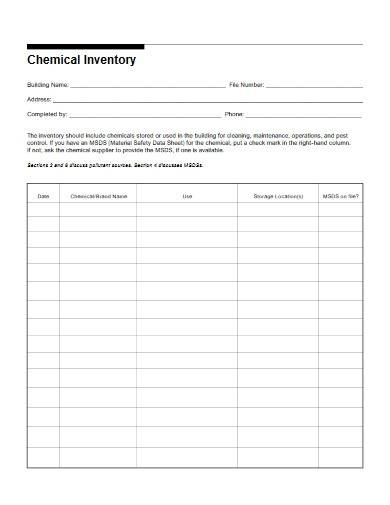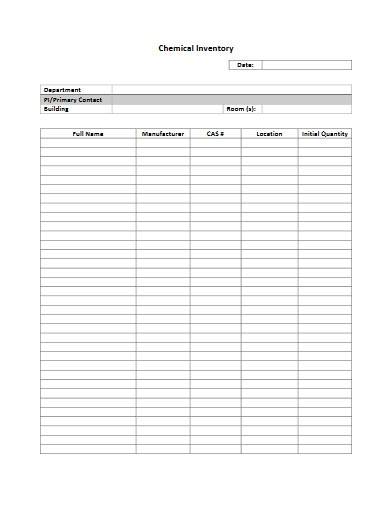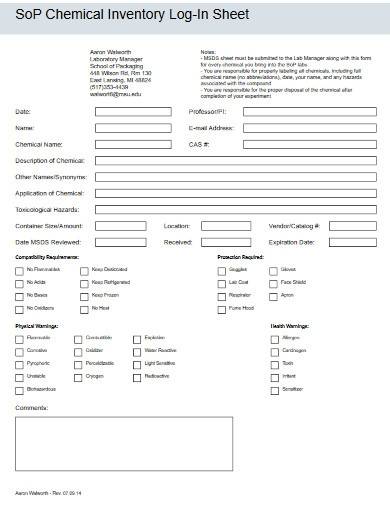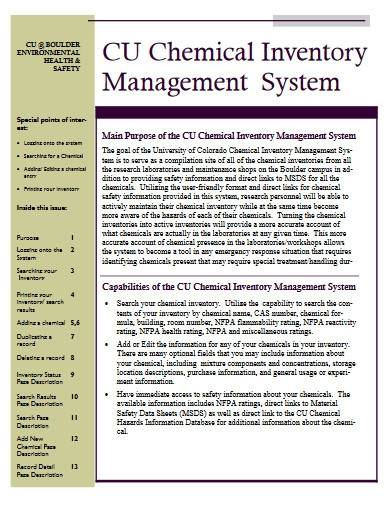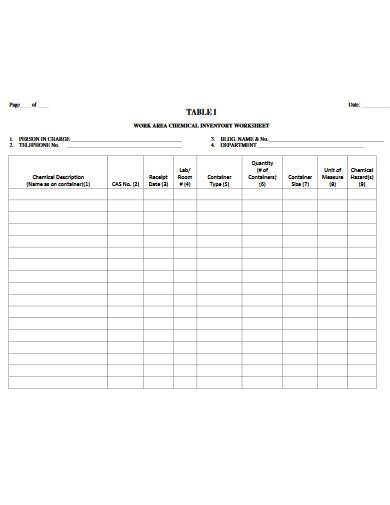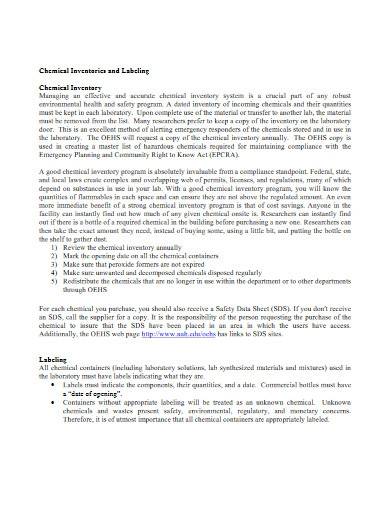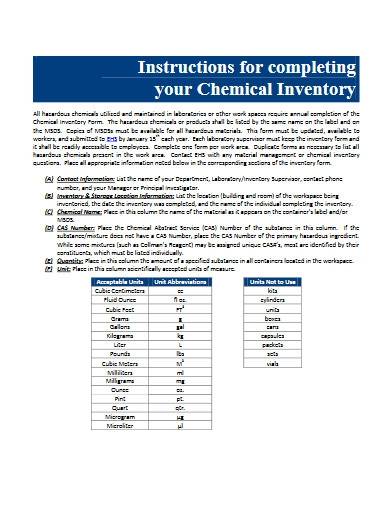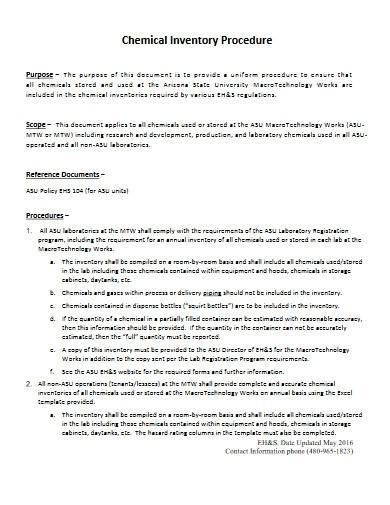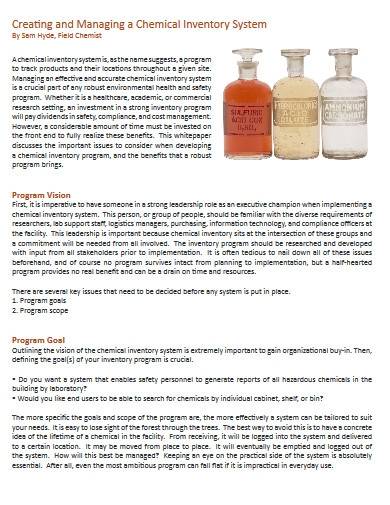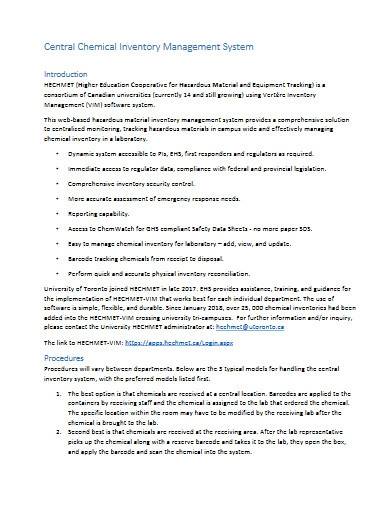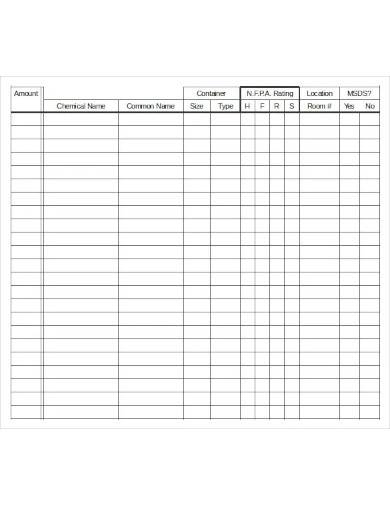Maintaining some well-detailed records of your chemical storage is beneficial to prevent employees from inadvertently causing a chemical hazard by storing incompatible hazards together. When a person stores incompatible chemicals together, it may result in generation of heat, fumes, gases and vapours that can quickly trigger a fire or explosion. In this article, we provide you some informative guide in creating a chemical inventory and choose from our collection of templates that you can use.
FREE 10+ Chemical Inventory Samples
1. Chemical Inventory Template
2. Sample Chemical Inventory Form
3. Sample Chemical Inventory Sheet
4. Chemical Inventory Management System
5. Chemical Inventory Worksheet Template
6. Chemical Inventories and Labeling
7. Sample Chemical Inventory List
8. Chemical Inventory Procedure
9. Sample Chemical Inventory System
10. Chemical Inventory Management System
11. Sample Chemical Inventory Template
What is a Chemical Inventory?
The chemical inventory is a list of every product used in the office that contains chemicals. It includes acids, disinfectants, glues, heavy metals, paint, pesticides, petroleum products and many more. Each time a new product containing a chemical is brought into the office, it must be added to the chemical list. If you’re in charge of keeping the chemical inventory of your company, you should be systematic, organized, attentive, mindful, and resourceful.
How to Create a Chemical Inventory
Unfortunately, many managers believe that chemicals are too significant to remove from a company’s core business definition but not essential enough to compete effectively for resources against the company’s authentic core business functions. Thus, good chemical management needs a great deal of information. Professionals and operators should be knowledgeable and understand how to use chemicals appropriately.
So, here are the useful tips and guides to assist you in creating a list:
1. Conduct a comprehensive review
First of all, you need to conduct a comprehensive review of the entire production and support processes including the cleaning, maintenance, power generation, etc. If you have newly purchased chemicals, these should be included in your chemical inventory list. Obtain and analyze chemical information of each chemical.
2. Know and understand different types of hazardous materials
If you’re not that familiar with some chemicals, research the products online and ask other chemical experts about the content of the chemicals. Know different types of hazardous materials and understand the possible reactions of certain substances. There are nine hazard classes: explosives, gases, flammable and combustible liquids, flammable solids, oxidizing substances, organic peroxides, toxic substances and infectious substances, radioactive materials, corrosives and miscellaneous hazardous materials.
3. Classify the chemical substances
For the significance of identification and inventory, it is necessary to categorize all the chemical substances, each with a distinguishing label. Carefully segregate chemical groups when organizing chemicals in a flammable safety warehouse.
An article explains that if there is a spill or a leak, properly categorizing your materials ensures that first responders and emergency personnel can determine the hazardous materials and know exactly what they are dealing with. The appropriate categorization of hazardous materials helps keep the safety of everyone.
4. Use an inventory template
An inventory template can help you to easily create a supply list of chemical inventory for your business. Include the chemical or product name, name/location/contact person of the supplier, name and percentage of chemical ingredients, hazard classification, amounts stored, usage quantity, etc.
FAQ
A chemical inventory list should include the following details:What is required on a chemical inventory list?
A hazardous chemical inventory list is simply a list of all products your practice has that have hazardous properties. What is a hazardous chemical inventory list?
Clean and organize each product. Label and/or bar-code materials. Carefully plan the work and execute the plan. Create chemical areas and be thorough. Audit as you work on checking the substances. Consider using inventory software. Plus, set up a routine inventory schedule.How do you manage chemical inventory?
According to an article, chemical inventories should be conducted on at least a yearly basis. Personnel should be looking at the physical condition of primary and secondary containers.How often should a chemical inventory be performed?
Therefore, improved chemical management practices can lead directly to increased business value and later contribute to the competitive success of the company. A proper management of chemicals raises business value by minimizing product costs, elevating product quality, and improving business capability. So, to help you in this matter, check out our sample inventory sheets. We hope that this article will help you keep much better chemical management to prevent possible accidents.
Related Posts
FREE 10+ Sample Warehouse Manager Job Description Templates ...
FREE 8+ Sample Pharmacy Technician Resume Templates in PDF ...
FREE 20+ Restaurant Business Plans in PDF MS Word | Pages ...
FREE 13+ Sample Quality Manuals in PDF
FREE 11+ Sample Certificate of Analysis Templates in Google Docs ...
FREE 61+ SOP Templates in PDF MS Word
FREE 25+ Maintenance Checklist Samples & Templates in MS Word ...
FREE 13+ Compliance Checklist Samples and Templates in PDF ...
FREE 11+ Laboratory Audit Report Samples & Templates in PDF ...
FREE 7+ Sample Biomedical Engineering Job Description ...
FREE 8+ Purchase Order Form Samples in MS Word PDF
FREE 9+ Salon Price List Samples in MS Word PDF
FREE 7+ Equipment Checklist Samples & Templates in Excel MS ...
FREE 9+ Painting Estimate Templates in PDF Excel
FREE 11+ Supply Management Samples in PDF DOC

